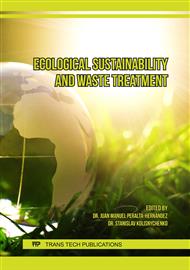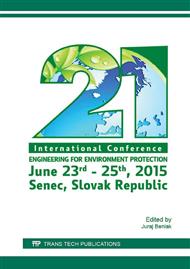[1]
Morvová, M. Využitie biomasy na energetické účely, Správa pre Konstruktu a. s. Trenčín. 2010. p.99.
Google Scholar
[2]
Tonhauzer, P. Využitie biomasy a odpadu ako suroviny pre obnoviteľné zdroje energie. [Dizertačná práca]. Bratislava : s. n., 2015. p.129.
Google Scholar
[3]
Jandačka, J., Malcho, M. Biomasa ako zdroj energie. [Online] 2007. [Cited: 22 10 2012. ] http: /www. biomasa-info. sk/docs/PriruckaBiomasaZdrojEnergie. pdf. ISBN 978-80-969161-4-6.
Google Scholar
[4]
Malaťák J., Vaculík P. Biomasa pro výrobu energie. Praha : ČZU v Prahe, 2008. p.206. ISBN 978-80-213-1810-6.
Google Scholar
[5]
Jandačka, J. et al. Drevné pelety a aditíva. Žilina : Juraj Štefuň - GEORG, 2011. p.129. ISBN 978-80-89401-23-9.
Google Scholar
[6]
Pelaez-Samaniegoa, M.R., Yadamac, V., Garcia-Pereza, M. et al. Effect of temperature during wood torrefaction on the formation of lignin liquid intermediates. Elsevier. Journal of Analytical and Applied Pyrolysis, 2014, Vol. 109.
DOI: 10.1016/j.jaap.2014.06.008
Google Scholar
[7]
Basu, P. Biomass Gasification and Pyrolysis. Oxford : Elsevier, 2010. p.365. ISBN 978-0-12-374988-8.
Google Scholar
[8]
Doymaz, İ. Air-drying characteristics of tomatoes. Elsevier. Journal of Food Engineering, 2007, Vol. 78, 4.
Google Scholar
[9]
Hitchin, P. Carbon neutral or a Trojan horse? [Online] Power Engineering International, 22 5 2013. [Cited: 17 3 2014. ] http: /www. powerengineeringint. com/articles/print/volume-21/issue-5/features/carbon-neutral-or-a-trojan-horse. html.
Google Scholar
[10]
Renewable energy world magazine. Building liquid markets for solid biofuel – Meetin the key criteria of quantity and sustainability. Renewable energy world magazine. 7-8 2012, Vol. 12, 4, pp.66-70.
Google Scholar
[11]
Wampler, T. Applied Pyrolysis Handbook. Boca Raton, London, New York : CRC Press, 2007. p.288. ISBN 978-1-57444-641-8.
Google Scholar
[12]
Vargas-Moreno, J.M., Callejón-Ferre, A.J. et al. A review of the mathematical models for predicting the geating value of biomass materials. Elsevier. Renewable and Sustainable Energy Reviews, 2012, Vol. 16, pp.3065-3083.
DOI: 10.1016/j.rser.2012.02.054
Google Scholar
[13]
Bučko, J. Chemické spracúvanie dreva. Zvolen : s. n., 2001. p.427. ISBN 80-228-1089-4.
Google Scholar
[14]
Bridgwater, A.V., Meier, D., Radlein, D. An overview of fast pyrolysis of biomass. Elsevier. Organic Geochemistry, 1999, Vol. 30, 12, pp.1479-1493.
DOI: 10.1016/s0146-6380(99)00120-5
Google Scholar
[15]
Fagbemi, L., Khezami, L., Capart, R. Pyrolysis products from different biomasses: application to the thermal cracking of tar. Elsevier. Applied Energy, 2001, Vol. 69, 4.
DOI: 10.1016/s0306-2619(01)00013-7
Google Scholar



